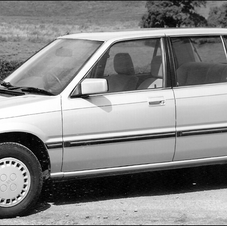The Vanden Plas Owners Club was established in 1980 and aims to help and encourage members to maintain these fine cars in good running order and appearance.
Rover 213/ 216 Vanden Plas
The Honda Ballade derived Rover 213 range was introduced on 19th June 1984. It was to be the first front-wheel drive Rover. A 4-door wedge shaped saloon it was powered by a new all-aluminium 12-valve Honda 1342cc engine which with a single twin-choke carburettor produced 70bhp at 6000rpm.
A 5-speed Honda manual transmission was used, there being no automatic or power steering option available. Front suspension was a torsion bar/tube spring design and the rear had a beam axle located by trailing arms and Panhard rod plus coil springs and gas filled dampers.
The top of the range Rover 213 Vanden Plas featured coachlines with 'VP' motifs on each rear wing, full moulded wheel covers with VP motifs, silver coloured radiator grille with chrome strip above, body coloured door mirrors, bronze tinted glass and a bright exhaust trim. The interior was trimmed in leather, shag pile carpet covered the floor, burr walnut door fillets and electric windows, central door locking, tachometer, headlamp power washers and a 3-band digital electronic stereo radio/cassette player were all standard. Air-conditioning was an extra cost option.
October 1984 saw the optional no-cost extra Raschelle upholstery replaced by Box and Plain velvet, leather remaining a standard fitment.
In April 1985 the Rover 216 Vanden Plas EFi was introduced to replace the Rover 213 Vanden Plas. The new model was powered by Rover's overhead camshaft 'S' series 1598cc engine as used in the Maestro Vanden Plas. However it was fitted with Lucas electronically controlled fuel injection and produced 104bhp at 6000rpm. A 5-speed manual gearbox remained standard but there was now an option of a 4-speed ZF automatic available at extra cost. To cope with the extra power, new servo-assisted disc brakes were fitted and the suspension was revised to give a much improved ride.
October 1986 saw the model revised. Wider body side mouldings and bumper strips were now fitted and access to the boot was vastly improved by the lowering of the loading sill now to bumper level. New slimmer rear lights, now incorporating reversing lights, were fitted. A new sliding/tilting glass sunroof was fitted as standard with electric operation an extra cost option (this became a standard fitment from Spring 1988). The twin door mirrors were now electrically operated and heated and inside the seats were redesigned and trimmed with ruched leather as standard or diagonal and plain velvet as a no-cost option. A new centre console was fitted incorporating a 6-speaker stereo radio/cassette player. A courtesy light delay was also amongst the standard fitments.
The model was discontinued in October 1989 being replaced by the new Rover 200/400 series.








